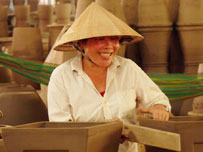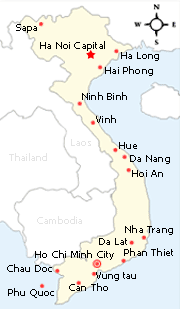Vietnam Open Tour News & EventsHeroes of the underground The extraordinary mazes on many levels total more than 200 kilometers in length and are full of nooks and crannies where freedom fighters and their civilian supporters lived, ate, stored food and weapons, cared for the sick and wounded, planned strategy and tactics, and fought the enemy.
Nguyen Tu, who works there, describes the multi-layered cobweb as a unique wonder of combat, a glorious symbol of the Vietnamese people’s heroism. The guerrilla fighters used the tunnels to conceal themselves from the enemy and launch surprise attacks seemingly out of nowhere, as well as to communicate and store arms and provisions. When American soldiers stepped into Cu Chi land for the first time, they would cry out “Underground village!”, “Danger zone!” or “Can’t see any Viet Cong yet they are everywhere!” They used the term "black echo" to describe the conditions within the tunnels, where fresh air, food and water were scarce but ants, spiders, mosquitoes and poisonous centipedes were not. A camouflaged trap door opens A visitor gets out of the camouflaged trap door A tourist fires an assault rifle at the shooting range Some tunnels have been enlarged to accommodate western visitors, and dim lights have been installed here and there to make the going easier Vestiges of bombs on display at the Cu Chi Tunnels site The guerrillas usually spent the daytime in the tunnels working or resting and only came out at night to scavenge for supplies, tend their crops or engage the enemy in battle. Sometimes, during periods of heavy bombing or American troop movement, the guerillas stayed underground for many days at a time. Illness was rampant among the tunnel dwellers, especially malaria, which caused more deaths than anything except battle wounds. Yet in spite of the hardship, the guerillas waged successful campaigns against a partly conscripted army that was technologically far superior, and eventually wore down their enemy. Today there are 121 kilometers of preserved tunnels at Cu Chi. They form a war memorial and a sort of school to educate visiting Vietnamese and foreign politicians, army officers, businessmen, students and indeed anyone with an interest in Vietnam’s struggle for independence. Millions of people from around the world have visited the Cu Chi Tunnels, among them Cuban former President Fidel Castro, Japan’s former Prime Minister Junichiro Koizumi, one of the Rockefeller billionaires, and politicians from Australia, France, Sweden and Russia. But they can’t upstage the real VIPs of Cu Chi. “You only need to crawl into the tunnel a few yards to understand how this tiny country could defeat the US, how this barren and poor land of Cu Chi could fight the good fight for decades,” says Tran Nguyen Minh, a HCMC tour guide with 20 travelers from France in tow. Thanks to the incredible system of tunnels, fortifications and combat trenches, the soldiers and civilians of Cu Chi District made a huge contribution toward their country’s reunification. Some tunnels have been enlarged to accommodate western visitors, dim lights have been installed here and there to make the going easier, and the booby traps have been clearly marked. Underground conference rooms where campaigns such as the 1968 Tet Offensive were planned have been restored, and visitors can now dine on the simple meals of Vietnam’s erstwhile freedom fighters. There are quite a few amusements above ground too, like the shooting range where visitors can fire an assault rifle. But Cu Chi is about the tunnels and the extraordinary people they housed. “It’s unbelievable!” exclaims Stephane Thomas from France as he climbs out of a manhole in the jungle floor. “Once it’s closed and camouflaged, it is almost undetectable,” Stephane declares. Most of Vietnam’s senior politicians have visited the tunnels. There’s an official Cu Chi website where current Party Chief Nong Duc Manh hails the underground maze as “an exploit of supreme intelligence.” There’s still much work to be done, like restoring the abandoned jeeps, tanks, bulldozers, crashed helicopters, artillery and unexploded bombs that still litter the landscape, and putting them on display (after the bombs have been rendered harmless, of course). An old saying has it that “Forests also feel resentment, mountains also feel hate”, which is why the damage to the land and trees of Cu Chi is being gradually repaired. It’s quite a job as the area was pounded by countless bombs and sprayed with by toxic chemicals. Today in Cu Chi, the tunnel dwellers of yore tell visitors about their underground lives and experiences, how they dug and fortified the tunnels, and how they beat G.I. Joe. Since 1990, the number of visitors has swelled to more than one million a year. They come out of curiosity and a desire to learn about the tunnels and the strong-willed people of Cu Chi and discover how they overcame massive opposition and cruelty. In the words of Cu Chi Tunnels director Tran Van Tam, the tunnels are “an integral part of the Vietnamese people’s heroic struggle, a legend of the twentieth century.” An illustration of the Cu Chi Tunnels complex Reported by Ha Anh - Thanhniennews Zooming over Nha Trang Bay Mai Linh Group has been test-flying motorized hang gliders at Do Island in Nha Trang Bay and will make them available to the public soon. The trikes, as they are commonly known, can reach an altitude of 3,000 meters but will be restricted to 150 meters, according to a regional executive of Ho Chi Minh City-based Mai Linh.
Ho Minh Chau, Mai Linh’s general director for the south central region and the Central Highlands, said each test flight lasted less than 20 minutes. Similarly, they can reach 70kph but will be restricted to 48kph for paying customers, he said. Quite a few people have been invited to take a test flight. One woman who claimed to be scared of heights described it as “sensational.” Another said flying in a motorized glider gave him a feeling of lightness and wonder. The trikes have two seats (one for the pilot), a three-blade propeller and a boat-like bottom for sitting in the sea. The wingspan exceeds 11 meters and the fuel tank at the rear can hold 40 liters. Donning a crash helmet and seat belt is a must before take- off. When everything is ready, the glider rolls down the sand into the water and lifts off when it reaches sufficient speed. Chau says Mai Linh plans to operate five trikes for tourists in Nha Trang. Anyone wanting to leave the pilot behind and go it alone will have to produce a flying certificate from the Vietnam Aviation Institute in Nha Trang. To be certified requires completing a training course and getting in 21 hours of flying practice. Reported by Phan Huy Tram - Thanhniennews
Traditional pottery-making in Vinh Long  Around 130 small businesses in Vinh Long specialize in producing artistic ceramics for export with most establishments concentrated in the province’s Mang Thit and Long Ho districts, and Vinh Long Town.
There are a total of around 2,800 kilns used to produce bricks, tiles and art in Vinh Long, which can be seen sitting in the open and resemble giant eggs buried in the ground. The kilns have a diameter of nearly 10 meters and stand more than 10-15 meters high. The large ovens – made of bricks, clay and sand – are most abundant along a route from the My Thuan Bridge toward Co Chien Estuary near Vinh Long Town. After arriving in Vinh Long, tourists can visit an area near the Co Chien River to learn about the pottery-making process. First, clay is collected from the earth, then kneaded into a more malleable substance. When it reaches a certain elasticity, the potters use it to shape various products. The ceramics are then set out to dry before being placed in a kiln. Baking the products in a kiln is a step that requires much patience and care. It can take months for a ceramic product to finish baking. During this process, the craftspeople must stay near the kiln to regularly check on the ceramics and make temperature adjustments. They check the temperature without using any specialized equipment and only people with years of experience can perform the job well. When the ceramics are finally finished baking, they are left to sit in the kilns until they have cooled sufficiently. Ceramics produced in Vinh Long are now exported to Europe, the US, Australia and several Asian countries and territories including South Korea, Japan, and Taiwan. Local business owners say that in time they hope to expand and export their products to more areas. Reported by Diem Thu - Thanhniennews BBC airs TV commercial to promote Vietnam tourism
Visit Dai Loc banh trang village Dai Loc has hundreds of families making banh trang for sale. Coming to Dai Loc this season, visitors will see banh trang drying everywhere in yards and gardens.
Vo Thi Bon, a woman who has produced banh trang for nearly 30 years, said that to have good banh trang, the rice must be good. Banh trang producers have to wash the rice, soak it in water for several hours and grind it into powder to make banh trang. In the photo: Bon is pouring wet powder into a basin.
VietNamNet/Dan Tri Indulging in ever green Cham Islet Heading to the ancient city of Hoi An in Quang Nam province this summer holiday, Cham islet, or Cu Lao Cham, is an ideal destination for guests to escape a bustling and hustling daily life as well as to escape the summer heat thanks to its wonderful sandy beaches, forested hills and clean, blue sea. The place is great for camping, swimming and scuba diving to explore coral reefs and beautiful marine life.
A view of Ong Beach on Cham islet, offshore Hoi An city in Quang Nam province. Cham Islands consist of eight islets with a total surface area of 40,000 hectares. Lao, Dai, Mo, Kho Me, Kho Con, La, Tai and Ong islets are home to only about 3,000 souls leaving the landscapes largely in pristine condition. The islet has 1,549 hectares of tropical forest and 947 species of marine life. The islets are cool and fresh round year, even in summer. The immense green of the forests harmonizes with the blue of the sea to create an endless green airspace. Cham islet’s Huong and Ong beaches are popular options for tourists because of the smooth sand and the small waves. Cham Islet is also home to diverse flora and fauna, especially abalone and sanglaganes, birds which have long been considered a delicacy by aristocrats and the wealthy. The islet also boasts 135 species of coral which are exciting discoveries for tourists. Since being recognized as a world biosphere reserve, local authorities have informed the public about environmental protection. Laws have been passed to protect the forests from decimation and investment opportunity has been limited to environmentally safe projects. Tourists are required to keep the island clean, said Le Van Giang, chairman of Hoi An city. Local authorities have also asked residents and tourists to use paper bags instead of plastic bags. VietNamNet/SGT News for Thursday 18 June, 2009 View all news for Thursday 18 June, 2009 on one page Recent News
|
|||||||||||||||||||||||||||||||||||
























